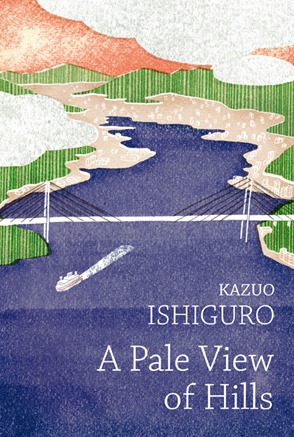Because,
Memory, I realize, can be an unreliable thing;
often it is heavily coloured by the circumstances in
which one remembers, and no doubt this applies to
certain of the recollections I have gathered here.Etsuko, A Pale View of Hills
The theme of memory is one of the recurrent motifs connecting the first three novels by Kazuo Ishiguro. In An Artist of the Floating World, the main character, Masuji Ono uses memory as a powerful device for dissociating himself from the past activities during the World War II. The Remains of the Day concerns Stevens whose memory is a just a screen for his numerous regrets.
The main character of the novel A Pale View of Hills, Etsuko is middle-aged woman from Japan, now living in the English countryside. The novel concerns her daughter Niki (the child of Etsuko’s marriage with Englishman) and her late daughter Keiko (the child of Etsuko’s first marriage with Japanese businessman), who committed suicide. The story of a young woman named Sachiko and her daughter Mariko plays a crucial role in the novel. The present events and memory of the past (while Etsuko lived in Japan) create a tangled web of regret and guilt.
Niki’s visit to Etsuko is intertwined with Etsuko’s reminiscence of her life in Japan. While in Nagasaki, Etsuko meets Sachiko and her daughter, who live in the unelectrified cottage near the Etsuko’s apartment. The reader learns that Sachiko’s husband has died in the World War II. Sachiko is proud that she comes from a distinguished family, even though the distinguishedness can be only seen in her old and delicate teapot.
Although Sachiko’s American friend has betrayed her many times before, she tries once again to leave Japan and go to America with him. Her selfishness begins to surface when the reader discovers that Mariko does not go to school and that Sachiko leaves Mariko wandering in the woods at dark. Mariko has undergone traumatic experiences in Tokyo and because of that she imagines seeing a woman wanting her to take her to the woods. Even though Mariko has serious mental problems, Sachiko has no qualms about it saying that Mariko has made it up. All in all, we create an image of a selfish and egocentric mother.
 On the other hand, Etsuko does not want to talk with Niki about Keiko even though, quite ironically, Keiko is their only subject of conversation. At moments, Etsuko feels regret about having to leave Japan and she feels guilty of Keiko’s death. She fancies Keiko’s ghost is still in Keiko’s old bedroom. Clearly, she feels a great amount of regret, but the reader is deprived of the real reason why she feels like that. Only at the end of the novel did Etsuko admit her failings and tells Niki:
On the other hand, Etsuko does not want to talk with Niki about Keiko even though, quite ironically, Keiko is their only subject of conversation. At moments, Etsuko feels regret about having to leave Japan and she feels guilty of Keiko’s death. She fancies Keiko’s ghost is still in Keiko’s old bedroom. Clearly, she feels a great amount of regret, but the reader is deprived of the real reason why she feels like that. Only at the end of the novel did Etsuko admit her failings and tells Niki:
“But you see, Niki, I knew all along she wouldn’t be happy over here. But I decided to bring her just the same”.
The plot is constructed in the way that the reader can notice a parallel between Etsuko and Sachiko. They are both constantly making excuses for their actions. They are both constantly reminding themselves that they have made right decisions. When Sachiko decides that she wants to leave Japan, she repeatedly tries to convince Etsuko that she has been planning her and her daughter’s future wisely. Etsuko rarely comments on Sachiko’s personal affairs. However, Sachiko constantly repeats: “But why can’t you understand that I’ve nothing to hide, I’ve nothing to be ashamed of”? Also, after talking about Keiko with Niki, Etsuko says:
But such things are long in the past now and I have no wish to ponder them yet again. My motives for leaving Japan were justifiable, and I know I always kept Keiko’s interest very much at heart.
Having this information on mind, we may conclude that Sachiko and Etsuko are quite similar. We may conclude that Etsuko does not have enough strength to talk about her guilt openly. She needs another story to face the guilt more easily. Ishiguro explains, “it’s really Etsuko talking about herself, the meanings that Etsuko imputes to the life of Sachiko are obviously the meanings that are relevant to Etsuko’s own life. Whatever the facts were about what happened to Sachiko and her daughter, they are of interest to Etsuko now because she can use them to talk about herself.” Furthermore, he adds,
“the whole narrative strategy of the book was about how someone ends up talking about things they cannot face directly through other people’s stories. I was trying to explore . . . how people use the language of self-deception and self-protection.”
Finally, we proceed to the role of memory in the novel. By recollecting past times, Etsuko tries to get to grips with Keiko’s death. Etsuko’s memory reveals another side of her, a side which she constantly tries to hide from the reader.
More reviews on Ishiguro’s books:
Remains of the Day: Film Adaptation Flaws
An Artist of the Floating World – The Character of Masuji Ono
- Humour and linguistics - November 25, 2015
- Around the world in bookish news: From Shakespeare to Jane Austin - September 23, 2015
- Around the world in bookish news: Book Jackets Go Live and Other Stories - September 16, 2015




